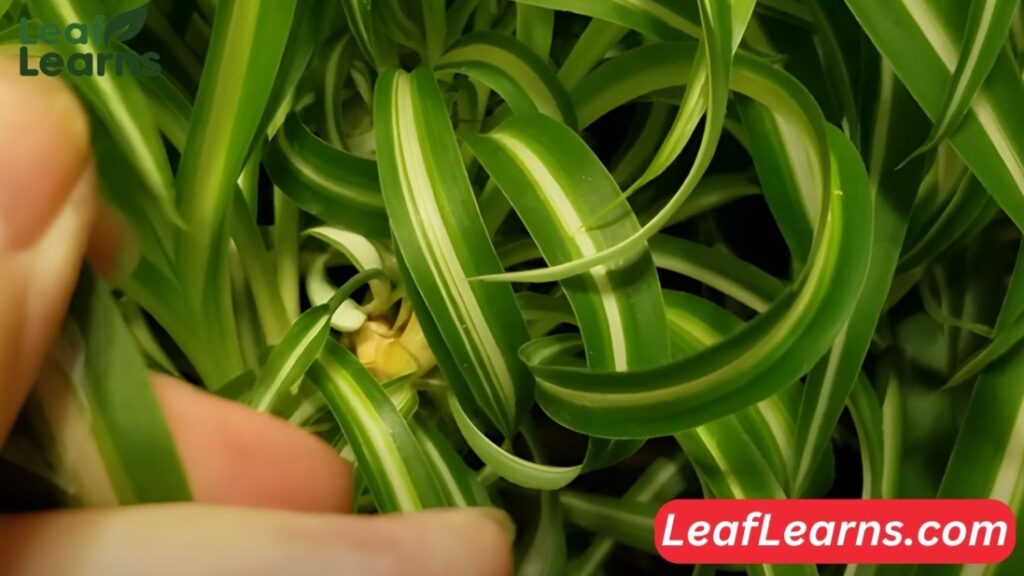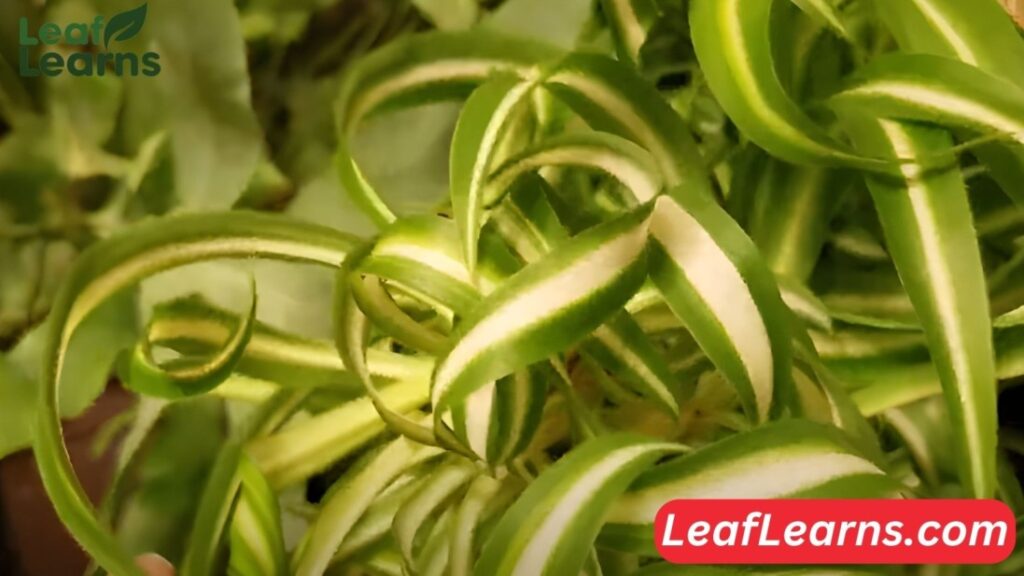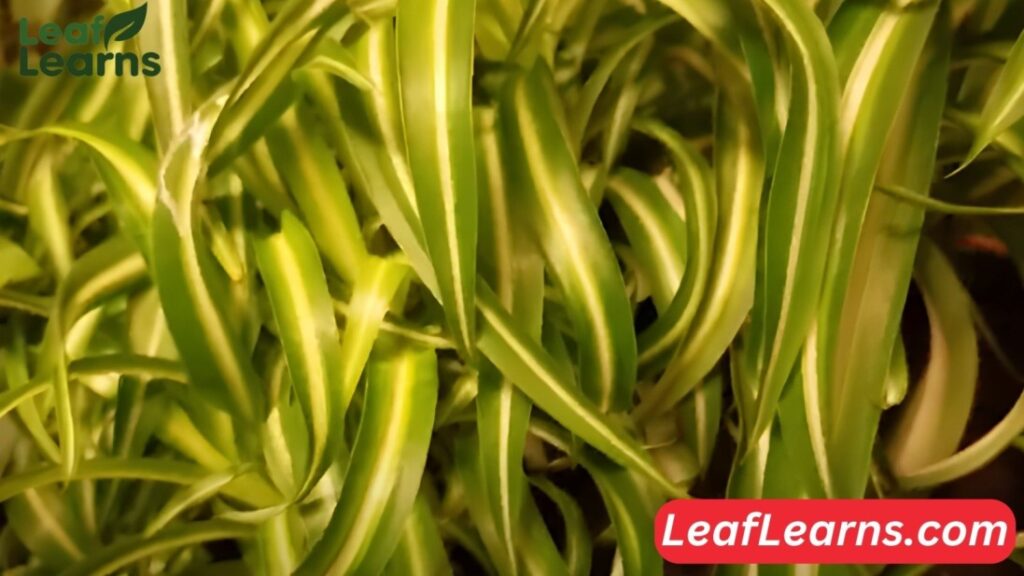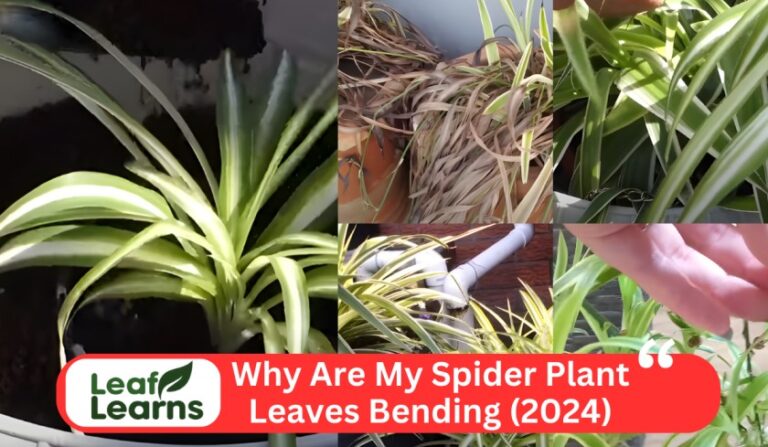Why are My spider plant leaves curling – Leaflearns (2024)
Spider plant leaves curling due to common issues like improper watering and low humidity levels. Also, there are factors such as the insects slaughtering or the fungal infection called root rot that can contribute to this problem. The leaf can curl when the plant receives direct sun or regular tap water.

Identifying these signs is key in this stage; they are evidence that there is a disease and requires immediate control. For tackling the leaf curling problems, regulating watering habits, boosting humidity levels, and supplying indirect sunlight are effective steps to help get plant out of the stress, supporting it, to grow healthier leaves.
Contents
Causes of spider plant leaves curling
Underwatering
Like all living things, spider plants need enough water to survive. As a survival strategy, they curl their leaves inward to reduce moisture loss through transpiration when plants don’t get enough water. Your spider plant is thirsty and requires care if it is spider plant leaves curling.
How to Fix Underwatering
Check Moisture Levels: Using your finger, probe the soil periodically to see how moist it is. Water it if it seems dry around one inch down.
The Right Way to Water: Make sure you wet the pot thoroughly by letting the water run down the bottom of the pot. To avoid root rot, discard any extra water in the saucer.
Boost Humidity: Spider plants prefer conditions that are a little bit humid. Increase the humidity by putting a humidity tray close by or spraying the leaves.
Keep an eye on environmental factors: Temperature and air movement are important considerations since drafts and dry air can hasten the evaporation of moisture.
Overwatering
Because of their hardiness, spider plants can get stressed by over-watering. Overwatering causes root suffocation, which hinders the plant’s efficient uptake of nutrients and water. Consequently, the leaves could show symptoms of distress such as spider plant leaves curling or browning tips.
How to Fix Overwatering
Evaluate Soil Moisture: Using a finger inserted approximately an inch deep, measure the soil’s moisture content regularly. It is a sign of overwatering if it feels damp or slick.
Modify Watering Frequency: Let the soil become dry in between applications of water. Well-draining soil that is slightly damp is ideal for spider plant growth.
Enhance Drainage: Make sure the drainage holes in your plant container are large enough to allow excess water to flow off and keep moisture from building up at the roots.
Eliminate Extra Water: If the water around your spider plant is standing, gently tilt the container to remove the extra water and avoid root damage.
Prune Affected Leaves: To encourage new development and lessen stress on the plant, trim any leaves that have sustained significant harm.

Water Purity
Spider plants are sometimes delicate to the water quality that they are given. Water contaminants like fluoride and chlorine, or minerals that combine with them, can harm a plant’s health and cause problems like leaf curling.
These contaminants can cause the plant’s nutritional and water balance to be upset, which can cause the leaves to curl or become brown.
How to Fix Water Purity Issues
Use Filtered Water: When watering your spider plant, use filtered water or gather rainwater. This aids in the removal of potentially dangerous minerals and contaminants from tap water.
Let Water Sit: Before watering your spider plant, let tap water sit for a full day. This lessens the possibility of chlorine and other volatile chemicals harming the plant by allowing them to disperse.
Watering Frequency: Modify the watering schedule to avoid standing water in the ground. To prevent instances where the soil becomes too wet, make sure it dries out a little between waterings.
Flush the Soil: To get rid of any salt or mineral accumulation that could be harming the health of the plants, periodically flush the soil with distilled water.
Soil pH
Spider plant leaves curling is significantly influenced by the pH level of the soil. The plant’s capacity to absorb vital nutrients may be hampered by excessively high or low soil pH, which can result in leaf curling.
With a pH range of 6.0 to 7.0, spider plants prefer slightly acidic soil over neutral soil. pH imbalances in the soil can cause stressed foliage by obstructing the uptake of nutrients.
How to Fix Soil pH Issues
Test Soil pH: To start, use a soil pH testing kit to find out the soil’s pH level. You may use this to assess whether the pH of the soil needs to be adjusted.
Modify pH using Amendments: Add acidic materials, such as compost, peat moss, or sulfur, to the soil if its pH is too high (alkaline). To increase the pH of acidic (low pH) soil, add dolomite or lime.
Gradual Adjustment: To prevent stunning the plant, make small changes to the pH of the soil. Gradually add modest quantities of amendments, and periodically retest the soil to track development.
Preserve pH Balance: After the ideal pH has been reached, preserve it by adding organic matter to the soil and watering it with pH-balanced water.
Root Rot
Spider plants frequently suffer from root rot, especially if they are overwatered or placed in poorly draining soil. Overly wet conditions surrounding the roots foster the growth of fungi, which causes root rot.
When the roots deteriorate, they lose their capacity to efficiently absorb water and nutrients, which causes symptoms including curling, yellowing, and withering of the leaves.
How to Fix Root Rot
Examine Root Health: Gently take the spider plant out of its pot and look for any evidence of decay in the roots. Rotten roots have a dark, mushy, or slimy appearance, whereas healthy roots are solid and white.
Cut Affected Roots: Remove decayed or damaged roots using pruning shears or sterile scissors. To stop the illness from spreading further, remove any afflicted areas and make sure the wounds are clean.
Repot in New Soil: Use a potting mix that is designed especially for houseplants and has good drainage. The spider plant should be replanted into a tidy, suitable-sized container with enough drainage holes.
Modify Your Watering Schedule: To avoid soggy conditions and the growth of fungi, let the soil dry out a little between waterings. Only until the top inch of soil appears dry to the touch should you water the plant.
Pests Infestation
Aphids, mealybugs, and spider mites are among the pests that can infest the spider plant leaves curling, stems, and roots of spider plants.
These pests harm the leaves and produce symptoms including yellowing, curling, and stunted development because they feed on the sap of the plant.
How to Fix Pests Infestation
Examine the Plant: Pay close attention to any indications of pests, such as webs, sticky residue, or small insects on the leaves and stems of the spider plant.
Treatment methods: Using natural predators like ladybirds to limit the population, hand-removing pests, cleaning the plant with insecticidal detergent, and so on, depending on the extent of the infestation, are the available treatment methods.
Isolate the Plant: To stop the pests from spreading to other plants, you may want to try isolating the spider plant if the infestation is severe.
Enhance Cultural Customs: By routinely clearing the area around the plant of dead leaves and debris, you may maintain good cleanliness. To prevent the growth of pests, make sure there is enough air circulation and avoid overwatering.
Size Of The Pot
Spider plant leaves curling can be affected by the size of the container; incorrect sizing can result in problems like leaf curling.
A spider plant may get root-bound, that is, have its roots packed and constrained if it is housed in a container that is too tiny.
On the other hand, a too-big pot may cause the soil to retain too much moisture, which might result in soggy conditions and root rot. These circumstances may cause stress to the plant, resulting in signs like yellowing and curling of the leaves.
How to Fix the Size of the Pot
Analyse Pot Size: Consider the size of the pot about the root system of the spider plant. The container should ideally be just big enough to allow for adequate root development.
Repot if required: If the plant is root-bound and the pot it is in is too small, carefully move it into a little bigger pot that has enough drainage holes.
Select the Correct Pot Size: Choose a pot that is one size bigger than the one you are using now so that the roots have enough space to spread out.
Verify Appropriate Drainage: To avoid waterlogging, make sure the new pot has enough drainage holes and uses a potting mix that drains efficiently.
Temperature Stress
Temperature variations can cause stress to spider plant leaves curling. A plant’s physiological processes may be disturbed by exposure to severe temperatures, drafts, or abrupt changes in the environment; in response, the plant may curl its leaves.
The plant may experience shock from cold gusts or excessive warmth, which can cause symptoms like curling, browning, or withering of the leaves.
How to Fix Temperature Stress
Ideal Temperature Range: Keep daytime temperatures between 65 and 75°F (18 and 24°C), and nighttime lows of a few degrees.
Prevent Drafts: To avoid temperature swings, keep spider plants away from draughty doors, windows, or air vents.
Provide Enough Airflow: Make sure the plant has enough airflow all around it, but keep it out of the direct path of any heating or cooling systems.
Protect against Extreme Temperatures: If the plant is exposed to particularly high or low temperatures, think about relocating it indoors or adding more insulation.

Direct Sunlight
Spider plant leaves curling when exposed to direct sunshine. Although bright, indirect light is what spider plants like, direct sunlight can scorch their fragile foliage, which causes them to curl their leaves in defense.
Sunburned leaves might take on discolored, wilted, or curled characteristics due to prolonged exposure to direct sunshine.
How to Fix Direct Sunlight
Indirect Light: Position your spider plant next to a window that faces north or east, or any other area that receives bright, indirect sunlight.
Filtered Light: To lessen the intensity of direct sunshine, use sheer drapes or blinds to screen the light.
Rotate the Plant: To guarantee uniform light exposure and avoid one-sided leaf curling, rotate the plant regularly.
Provide Shade: To shield the plant from direct sunlight during the warmest part of the day, transfer it to a shady spot if the weather permits.
Nutrient Deficiencies
Nutrient deficits can cause spider plant leaves curling, especially if they are deficient in important components like nitrogen, potassium, or magnesium.
Depletion of the soil or improper nutrient absorption by the plant can result in nutritional deficits. A lack of certain nutrients can cause stunted growth, yellowing, and curling of the leaves.
Restoring the plant’s health and vigor requires identifying and treating particular nutritional deficits.
How to Fix Nutrient Deficiencies
Soil Testing: To ascertain whether nutrients are deficient in the soil, do a soil test. Test kits for soil are widely accessible and yield precise findings.
Fertilization: Select a fertilizer that is water-soluble, balanced, and specially made for indoor plants. For information on application rates and frequency, refer to the manufacturer’s instructions.
Micronutrient Supplements: If any particular micro nutrient is lacking, you may want to think about adding organic amendments or micronutrient fertilizers as supplements.
Compost or aged manure are examples of organic matter that may be added to the soil to help with soil structure and nutrient retention.
Caring for Spider Plants: Essential Considerations
Spider plants, known for their resilience and air-purifying properties, require specific care to thrive. Understanding spider plant care is crucial, whether you’re in Pakistan, where spider plant price might vary, or in Germany, where it’s referred to as “spider pflanze” or “spider plant.”
Issues such as leaf curling are common concerns, with enthusiasts worldwide troubleshooting the causes and solutions. While spider plant leaves curling may stem from factors like inadequate watering or light exposure, it’s essential to differentiate these from broader plant leaf curling issues seen in various plants, including pilea and indoor plants.
Beyond care specifics, intriguing topics like spider plant symbolism or spider curls exercises may pique interest, illustrating the diverse facets of plant culture and wellness.
Final Thoughts
In conclusion, keeping spider plants healthy and vibrant requires an awareness of the reasons for their leaf curling.
Whether the cause is a lack of nutrients or exposure to sunshine, taking quick action to remedy these problems can help your spider plant grow lush new leaves again.
Your spider plant may bring beauty and greenery into your interior space if you give it the right care, keep an eye on its surroundings, and take any corrective action when needed.
FAQs
Why are my spider plant leaves curling inward?
Certain conditions, such as excessive watering, low humidity, or bright sunshine, might cause spider plant leaves to curl inward. This problem may be resolved by increasing humidity, adjusting the frequency of watering, and using indirect lighting.
How do you revive a curly spider plant?
To bring a curly spider plant back to life, evaluate its surroundings and take care of any problems it may be having, such as overwatering, nutritional shortages, or insufficient light. To encourage new growth, modify your watering schedule, fertilize with a balanced fertilizer, ensure your plants have enough light, and cut any damaged leaves.
How do you fix curling leaves on plants?
Determine the root reason for curling leaves on plants; they might be pests, environmental stress, overwatering, or underwatering. To promote healthy leaf development, modify watering schedules, eradicate any damaged foliage, treat pests if they are present, and provide ideal growing conditions.
How do you care for a curly leaf spider plant?
A curly-leaf spider plant needs regular watering, bright, indirect light, and the correct amount of humidity to thrive. To raise humidity levels and stop leaf curling, water the plant periodically, check the moisture content of the soil regularly, and fertilize sparingly during the growing season.






